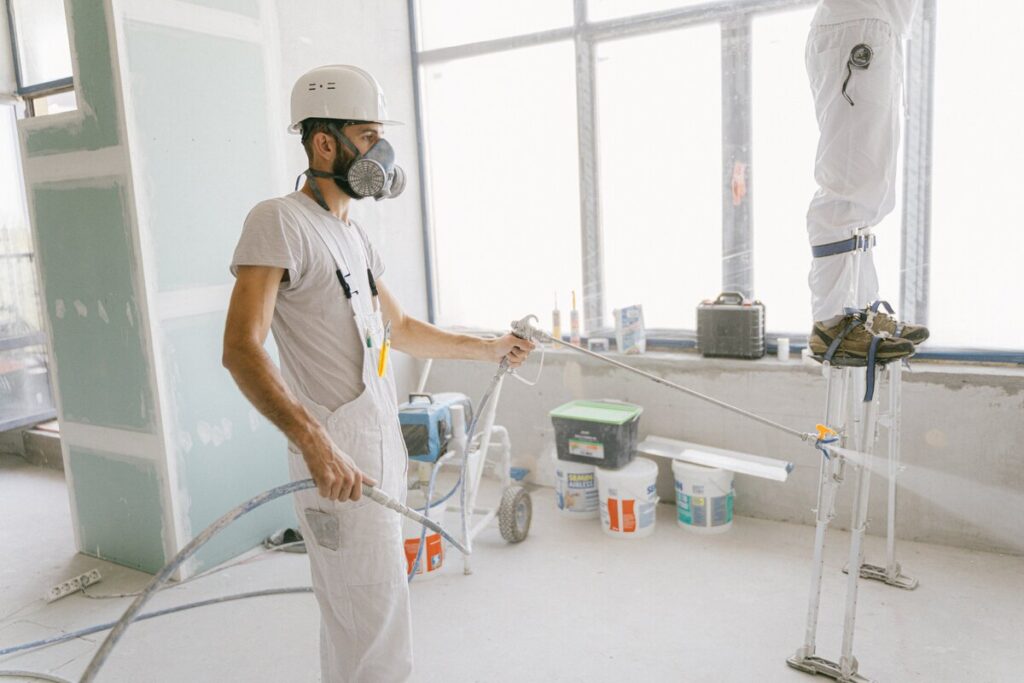Starting a plastering business can be a rewarding career move, especially in Australia, where demand for skilled trades is high.
With the country’s economy rising and many construction and renovation projects underway, now is a good time to establish a plastering business.
This guide will cover the essential steps to help you get started.
Let’s get straight to the point.
To start a plastering business, assess your skills, choose the right business structure (sole trader or limited company), and register your business. Obtain necessary licences, such as a contractor’s, and secure insurance, such as public liability.
Invest in essential tools and equipment, set competitive rates, and focus on building your client base through word-of-mouth, advertising, and an online presence. Ensure health and safety compliance, and consider expanding your team as your business grows.
These steps will help you establish a successful plastering business in a growing market.
Steps To Start A Plastering Business

1. Assess Your Skills And Experience
Evaluating your skills and experience is important before launching your plastering business. This trade requires hands-on experience and strong analytical and technical skills.
Here are a few things to consider:
- Experience: Being confident in your ability to deliver high-quality work is important. Your business’s success relies on the impression you make on your clients.
- Specialised Training: To offer niche services, consider taking additional courses in plastering, dry lining, or ornamental design. A specialised skill set will help you stand out in a competitive market.
Target Market Considerations
Identify who your potential clients will be. In the plastering business, typical customers include:
- Homeowners
- Landlords
- Business owners
- Construction companies
Take note of any trends in your local real estate market. For example, are there older homes that might require plaster repairs, or are there new builds where plastering services are needed?
2. Choose Your Business Structure
When starting a plastering business, one of the first decisions is selecting your legal business structure. You have two main options:
Sole Trader
- Pros: Easier to set up, minimal paperwork, and lower costs.
- Cons: You are personally liable for any business debts.
Limited Company
- Pros: Offers liability protection, separates personal and business finances, and may provide tax benefits.
- Cons: More paperwork and stricter accounting rules.
A limited company may be the best choice if you plan to expand and hire employees. It’s advisable to consult an accountant when deciding which structure best suits your needs.
3. Register Your Business
Once you’ve chosen a business structure, the next step is to register your plastering business. This involves:
- Registering your business name with the Australian Securities and Investments Commission (ASIC).
- Set up a business bank account to separate your personal and business finances.
This step ensures that your business complies with Australian laws and simplifies tax filing.
4. Obtain Necessary Licences
Plastering is a regulated trade in Australia, and you may need a contractor’s licence or a certificate as a qualified supervisor, especially if your projects exceed $5,000 in cost (including GST).
- Contractor’s Licence: You can legally undertake plastering work and collect client payment.
- Qualified Supervisor Certificate: Authorises you to supervise work carried out by others under your guidance.
Ensure you are licensed according to local state regulations, which will affect your ability to operate legally.
5. Prepare A Business Plan
A solid business plan is essential for any successful business. Your plan should cover:
- Short, medium, and long-term goals.
- Target market: Whether you’re focusing on residential or commercial plastering.
- Costing and pricing strategy: Understanding your overhead costs and setting competitive rates.
- Marketing strategy: How to reach potential clients (more on below).
A clear business plan can help you manage cash flow, attract clients, and secure necessary financing.
6. Invest In Tools And Equipment

Having the right tools is essential for a plastering business. You can either purchase or rent equipment, depending on your budget. Here is a list of essential tools:
- Trowel and hawk: Basic tools needed for applying plaster.
- Buckets and mixing tools: These are used to prepare plaster mixtures.
- Protective gear: Gloves, masks, and safety boots are crucial for safe working conditions.
- Vehicle: A van is recommended for transporting tools and materials to job sites.
Although purchasing equipment upfront may be costly, high-quality tools can improve work efficiency and help you achieve better results.
7. Secure Insurance Coverage
Insurance is vital in protecting your business from potential risks. Some types of insurance to consider include:
- Public Liability Insurance: Covers injury or damage to third parties while you’re working on-site.
- Employer’s Liability Insurance: Necessary if you plan to hire employees.
- Professional Indemnity Insurance: Protects you from claims related to any financial loss your work might cause a client.
- Tool Insurance: Safeguards your tools in case of theft or damage.
These insurances are essential for running a legal and risk-free plastering business.
8. Set Your Rates
Determining how much to charge is critical to your business success. Factors influencing your rates include:
- Location: Rates vary between regions depending on local demand for plastering services.
- Experience: Charge according to your skill level. A more experienced plasterer can justify higher rates.
- Certifications: You can charge more for your services if you’ve obtained recognised qualifications.
Make sure to account for all overhead costs when setting your rates to ensure profitability.
9. Build Your Client Base
Building a strong client base is key to long-term success. Since the plastering industry relies heavily on word-of-mouth, delivering excellent service is essential.
Here are a few strategies for attracting clients:
Word-Of-Mouth
Satisfied clients will recommend you to others. Provide top-quality work and customer service to ensure you leave a lasting impression.
Advertising
- Vehicle Signage: Place your business logo and contact information on your work van to promote your services while travelling.
- Flyers: Distribute flyers to potential clients, particularly in areas with high renovation activity.
- Online Presence: Having a website and maintaining social media profiles can help you reach a larger audience.
Consider listing your business on online directories where potential clients can easily find and
contact you.
10. Health And Safety Compliance
Health and safety are vital when running a plastering business. Hazards are common in construction sites, especially when working at heights or handling heavy materials.
You and any employees must follow Australian work health and safety regulations. This includes wearing appropriate protective equipment and ensuring a safe working environment for all parties involved.
11. Expanding Your Business
Once your plastering business is running, consider hiring additional workers to manage the workload. Here are some things to keep in mind:
- Employment Contracts: Ensure all new hires sign contracts outlining their responsibilities and employment terms.
- Workload Management: Decide whether to hire full-time workers or contractors based on your business needs.
Expanding your team will enable you to take on larger projects and serve more clients, but it is essential to manage this growth effectively.
Conclusion
Starting a plastering business can be profitable, especially with the growing demand for skilled trades.
By following the steps outlined in this guide—assessing your skills, choosing a business structure, registering your business, and marketing your services—you’ll set yourself up for success.
Remember to invest in the right tools, secure insurance, and comply with local regulations to protect your business and grow steadily.
With dedication and a focus on quality, your plastering business can thrive in a competitive market.
Frequently Asked Questions About Plasterer
How Long Does It Take To Learn to Be a Plasterer?
The length of time it takes to become a plasterer depends on your career path. A short course can teach you the ropes in weeks, or you can spend several years building up your skillset.
What Qualifications Do You Need to Do Plastering?
You can begin working as a plasterer’s labourer or ‘mate’. You may not need formal qualifications, but some employers look for on-site construction experience.
Is Plastering a Good Trade?
It is a versatile job as plaster is needed in many different construction times, from residential to commercial buildings, so you will constantly be engaged with a different site to work on.
Is Plastering Hard to Learn?
It is a skill, and it takes practice, care, precision and a lot of experience to get it 100% right. That is, however, not to say you can’t DIY plastering. Of course, you can, but you should know it’s going to take some time to learn the process and get to know what you’re doing.
Can I Teach Myself How to Plaster?
The DIY Plastering course will teach you to apply a flat base coat and a skim finish to a professional standard. You cannot be taught how to become a plasterer in just one day, but you can learn how to plaster to a good standard.

